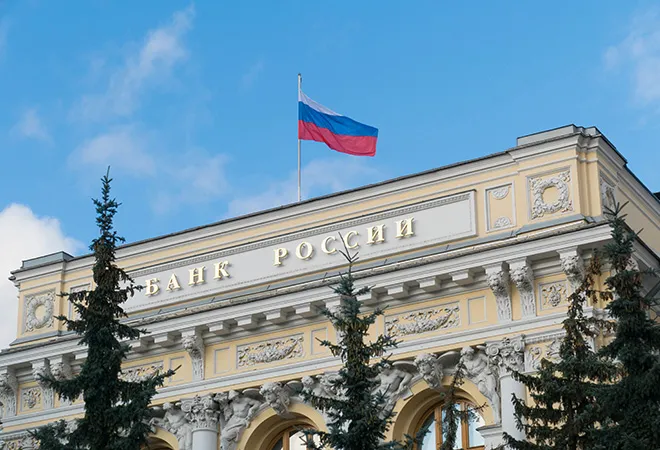
In early March, the Central Bank of Russia (CBR) raised its key interest rate by 25 basis points to 4.5 percent for the first time since 2018, in an attempt to control rising inflation which has hit food prices particularly hard. Another similar hike is now expected to be announced at the next meeting of the bank on April 23.
The move was prompted by the inflation touching 5.7 percent in February 2021, with the food inflation reaching 7.7 percent. The CBR now expects to reach its target of 4 percent inflation rate only by 2022, instead of this year. Apart from inflation, the bank cited ‘geopolitical risks’ to be the reason behind the rate hike. At the time, the decision was guided by fears of Western sanctions, which led to a depreciation of the rouble and prompted the central bank to raise the benchmark interest rate. Since then, the Biden administration has gone ahead and imposed sanctions on Russia, further complicating the economic situation even as the pandemic continues to make its impact felt.
In July 2020, there had been a rate cut by the CBR to deal with the fall in oil prices and to soften the impact of the pandemic by promoting economic activity. This direction was expected to sustain through 2022 to help the economy recover but as high inflation persisted, especially worrying in case of the rapid rise in food prices, a need was felt for the revision of monetary policy.
Declining incomes
Russia’s macro-economic situation remains stable, and the post-pandemic recovery is going better than expected with the IMF predicting a 3 percent growth in 2021. However, the steady decline in real incomes over the past years has made a rise in inflation a cause of worry. Owing to the pandemic, it has been estimated that disposable incomes in Russia reached an ‘eight-year low’ in 2020. But the issue did not begin with the pandemic, with real disposable incomes already declining for the fifth straight year by 2018. This has been attributed to a slowdown in economic growth brought about by a combination of low oil prices and Western sanctions over the Ukrainian crisis and annexation of Crimea, with Russian GDP growing at a slower pace compared to the world average.
There was a marginal improvement in 2019, when the income levels rose by 0.8 percent backed by higher spending by the government and low inflation levels. However, the gains were offset by the pandemic in 2020, and in the second quarter of the year, the real disposable income fell by 8 percent, a decline not seen since the economic turbulence of the late 1990s. As a result, when food prices started to go up owing to global factors including ‘disruptions of supply, stockpiling and speculation,’ the Russian government stepped in to issue price caps for sugar and sunflower oil in November 2020.
Similar measures were taken in 2021 for poultry and egg prices, where producers froze prices for two months. Steps were also taken to control exports of food grains by imposing export duties. But news reports indicate that ‘double-digit’ price rise of everyday items like sugar, eggs, meat, fruits, and vegetables, etc. has been witnessed in the past year, prompting the action from the CBR to bring inflation under control. These measures collectively were also important due to increased unemployment and rise in number of people living below the poverty line (a figure that rose by 700,000 compared to 2019) due to the impact of the pandemic.
The political cost
A Levada poll in early March revealed that 58 percent people see rising prices as the main problem facing the society. The polling agency noted that while this figure stands lower than 2018, when 72 percent of the respondents had noted price rise to be the main issue, it still remains at the top of the list. This was followed by poverty, corruption and bribery, and rise in unemployment at 40 percent, 39 percent and 36 percent respectively.
Given that state Duma elections are set for September and popularity of ruling party United Russia is at record lows of around 30 percent, price rise has emerged as a sensitive issue for the government. Now, the pandemic has also resulted in the postponement of national development goals—which included reducing poverty by half and ensuring growth of real wages above inflation level—from 2024 to 2030. In fact, analysts attribute some of the ‘propellant force’ of the protests against jailing of opposition leader Alexey Navalny in January-February 2021 to the weakening economic situation.
These developments have once again raised questions around the social contract between Russian citizens and the government, where the former exchanged economic prosperity for political loyalty towards the latter. This is not to say that there are signs of a mass movement on the issue of price rise. However, the focus is once again returning to the Russian economic situation, unlike the immediate years following the Ukraine crisis and annexation of Crimea, when nationalist sentiment outstripped concern over economic troubles. All of these factors together have made it important for the Russian government to address the immediate issue of price rise, to prevent trouble in an election year.
The road ahead
In 2020, the Russian economy shrank by 3 percent due to the impact of the pandemic. The services sector was hit the hardest while industrial production was down 2.9 percent last year. Much of the latter can be attributed to reduced demand for natural resources from the world market during 2020. Inflationary concerns remain, as the CBR lists various factors including unpredictability of global commodity prices, uncertainty regarding the spread of the pandemic, uneven economic growth, and geopolitical risks as affecting the situation. As a result, it is expected to further raise the rates in the coming months, before settling for a ‘neutral policy that neither stokes nor slows inflation’ by the end of 2021.
But in comparison to other several other European countries Russia’s recovery has been better, having decided not to impose a second lockdown even as cases rose in a second wave in September last year. The World Bank in its latest projections is predicting a growth of 2.9 percent in 2021. CBR expects the economy to reach pre-pandemic levels by the end of the year, and believes the inflation will also be within the target range of 4 percent by then.
Overall, IMF has described the immediate Russian policy response to deal with the economic challenges arising out of the pandemic as ‘strong.’ But it has also simultaneously expressed concern over the weak economic growth even before the pandemic hit, calling for structural reforms in sectors like infrastructure, rule of law, governance, and business environment. In a nutshell, the challenge going forward would be to achieve a higher growth rate to improve disposable incomes and living standards of the people, even as uncertainty related to the COVID-19 pandemic lingers on.
The views expressed above belong to the author(s). ORF research and analyses now available on Telegram! Click here to access our curated content — blogs, longforms and interviews.




 PREV
PREV


